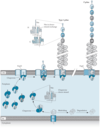patho exam 3 Flashcards
(251 cards)
bacteria strategies for evading or surviving host defense systems.
Man and animals have evolved many strategies for defending themselves against bacterial invation. Battle of evolution, as bacteria develop methods to overcome these defenses.
Most of these strategies can be thought of as those aslo suited to a natural enviroments.
i.e. properties such as adherence can be just as useful in staying close to a nutrient source as bacteria sicking to teeth or heart valves ect.
Defenses against protozoa are akin to avoid phagocytosis involved in the immune system.
virulence factors?
the properties (gene products) that enable a microorganism to establish itself on or within a host and enhance its potential to cause disease.
samonella
gram negative

pathogencic interations
- enter the body, attach to host cells for colonization
- evade the host innate and adaptive immune systems and persist in the immuno-evasion or immuno-suppression.
- Obtain nutrients and other requirements susch as iron
- Disseminate (sprad) within the host, replication and travel to other hosts.
- these may result in symptoms from the bacteria/ bacterial products ( i.e. toxins)

Preinfection
factors to consider?
Survival in the External Enviroment Reservoir?
Must be able to survive in the enviroment but also adapt to rapid changes?
- production of endospores to survive harsh enviroments
- Gram +ve walls to help reduce dehydration and protein oxidation
* Animal—animal—human—-human-human
* Enviroment to human
- Gene expression of new proteins
- Production of secondary metbolites - acids, antibiotics, bacterocins, antimicroial products, biofils
Most frequent Entry Portals
- skin
- Intestinal tract
- Respiratory tract
- Genitourinary tract
and many others
medical and dental related entry portals

preferred portals of entry
- many microbs have to enter in a specific manner and in a specific place to cause disease.
- ex vibrio cholerae infects the GI tract therefore, rubbing and infected oyster on a wound of the skin will not caused cholera.
- cross referance modes of transmission in section 2
Penetration of Skin or Epithelial Layer
- Skin -normal does a good job of preventing entry but can be breached
- surgery, catheters, trama, burns
- Biting arthropods?
- Tick,mouse,deer interations
- Borrelia burgdoferi- lyme disease
-
pareternal infections
-by some rout other than through the alimentary canal, such as by subcutaneeous, intramuscular or intravenous injection.
Microorganisms are depositied into the tissues below the skin or mucous membranes
- Puntures
- Injections
- bites
- scratches
- surgery
- splitting of skin due to swelling or dryness.
skin
when intact - it is normally impentrable
- when integrity lost then it becomes portal for entry
- hair folicles and Sweat gland ducts ( many have antimicrobial oils for production)
colonization and invation of host
it has been proposed that the reason the skin and immune systems are so effectiv e for the great majority of organisums is that the host-microbe relationship maybe viewed as somewhat short( evolutionary time).
No bacterium can borrow or penetrate skin alone with so form of breach.
-But there aer many virulence factors that have evolved that promote colonization and survival.
first steps
- penetration of skin
- penetration of the Epithelial and Mucin Layers
Rickettsial Diseases
Rickettsias are small bacteria,
- gram negative
- non-sporeforming
- strictily obligate
- intracellular
- in vertebrates - associated with/ fleas, lice or ticks.
- not cultured in laboratory media
– only in lab animals, mammalian tissue culture and yolk sac of chick embryos.
Rickettsia prowazekii-
common body or head louse, causes
- Typhus
- 3 million death in WW1 among troops, unsanitary conditions, caused more deaths than combate.
Human Louse

Rickettia prowazekii-typus
Borrelia recurrents- relapsing fever
Bartonella quintana-trench fever
Pool feeding
bite of louse puntures skin
- makes a trough
- blood pools and the bacterium enters from louse fecal matter which is aided by scratching
- Bacteria multiply in the cells lining blood vessles that eventually lyse resulting in the skin rash.

Penetration of Epithelial or Mucin Layers
Respiratory tract
- easiest portal to enter and most commonly infected
- Many microbs travel in aerosols which we breath
- ex. cold, TB, influenza,smallpox,Pneumonia
Penetration of the Epithelial or Mucin Layers.
Gastrointestianl tract
- Through food, water and dirty fingers
- Must overcome low pH of the gut
- Ex. Amobic dysentary, Hepatitis, Shigellosis
Penetration of the Epitelial or Mucin Layers
Genitourinary tract
- for STDs
- Broken (parentral route) or unbroken membranes ( depends on the microb
- Ex. HIV, Genital warts, Herpes, Syphillis
Epithelial Layer
-Nesseria gonorrhoeae
-STD attaches to urogenital epithelia more tightly than other tissue via
–Protiein Opa (opacity associated protein).
- Opa binds specifically to host cells processing the protein
- CD66- only found on human epithelial cells.
epithelial Layer
-Evolutionary pressure have made this organism host specific
- behavior of host- transmission, reproductive process?
- procreation (reproduction) vs Recreation
what is Mucin?
Network of protein and polysaccharide
what does Mucin do?
general and specialized functions
- prevent bacteria reaching mucosal cells
- Gi and vaginal tracts act as lubricats
- Goblet cells
- Respiratory tract- ciliated cells expel bacteria caught in mucin
- secoundary infections with colds and flu?
- Mucus is expelled in long streams that forms a network of tangled strands
- however pathogens have sought out weaknesses.






















